List of Most Common Lungs Diseases in The World
What Are Lungs Diseases?
The lungs diseases are the conditions which affect the functioning of your pulmonary organs. Human beings have two lungs which are very important organs of the body. Specifically, they perform the function to inhale oxygen. Meanwhile, different pulmonary conditions make you unable to get sufficient oxygen from the environment.
Do you know an individual normally breathes 25,000 times a day? When you inhale, your lungs receive oxygen and forward it to the blood circulatory system. Finally, the blood delivers oxygen to every individual cell in the body.
This respiratory gas is necessary for growth of the cells. Basically, it helps in the process of extracting energy from food. Sometimes, you probably find it hard to breathe. It is because of the lungs diseases which may occur due to air pollution, allergy and chemicals. The condition is likely to become worse. U.S is one of the most effected countries of the world with lungs diseases.
The major cause of lungs diseases is smoking. However, they can also be due to genetic factors. There are many ways through which you classify lung diseases in the world. These factors include symptoms, causes, patterns, and so on.
There are different categories of lungs diseases, for example, inflammatory, obstructive and restrictive lungs diseases. Here is the list of most common lung diseases in the world.
Emphysema
Emphysema is obstructive and one of the most lethal diseases of lungs that is lasting and intense in nature. The main causes are smoking and too much exposure to pollution. The sufferers face breathing problem, which is the major symptom.
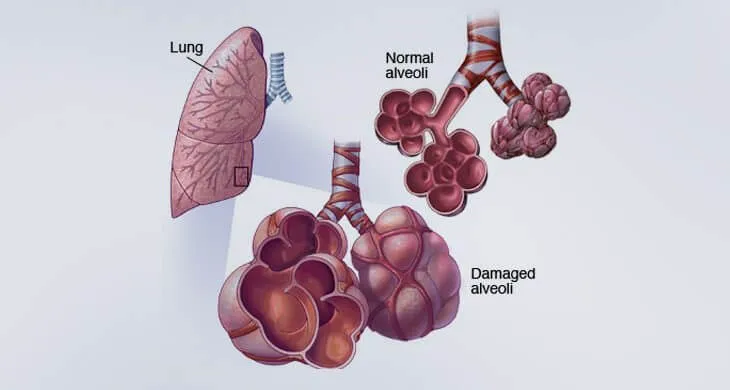
In this condition, the cells which support the function of lungs are dissolved. Resultantly, there is also a harmful effect on the physical shape of lungs.
Emphysema Symptoms:
- Shortness of breath due to structural changes in the lungs.
- Appearance of air pockets in the lungs.
- Cough and feeling of tightness in the chest.
- Loss of appetite and poor sleep are, however, the less common symptoms.
Emphysema Treatment:
For the diagnosis of emphysema, the doctors take help from the patient’s history, physical and different types of pulmonary function tests. On the other hand, the focus of different treatment methods is to improve the emphysema symptoms. For this purpose, the doctors may recommend oral drugs, oxygen therapy and lung volume reduction surgery. The final option is, however, that of lung transplantation.
Asthma
Asthma is combination of obstructive and inflammatory lung diseases. The attacks can be alarming at places containing tobacco, medications, chemicals, factory fumes and dust, etc. However, these cases are highly diverse in their nature and may not be specific to allergens.
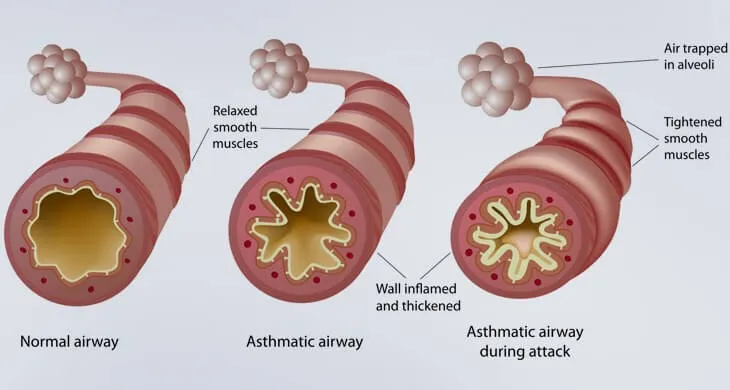
Asthma Symptoms:
- Inflammation and tightening of bronchial tubes.
- Coughing which becomes severe at night.
- Pain and pressure in the chest region.
- Wheezing and shortness of breath.
Asthma Treatment:
Initially, doctors prescribe asthma inhalers, oral medications and the asthma drugs. The patients receive such drugs through the breathing machine. Meanwhile, you cannot deny the importance of self-care. To make the self-care effective, the patients need to have a better understanding of the conditions and go through some tips.
COPD
COPD or Chronic Obstructive Pulmonary Disease has many names such as COLD and COAD, etc. Here COLD stands for chronic obstructive lung disease while COAD is an acronym for chronic obstructive airway disease. It is a lung disorder in which problem of breathing occurs when airways are narrowed.
The narrowing of airways is because of the Emphysema and Chronic Bronchitis diseases. It mostly occurs due to tobacco smoking and sometimes by gas.
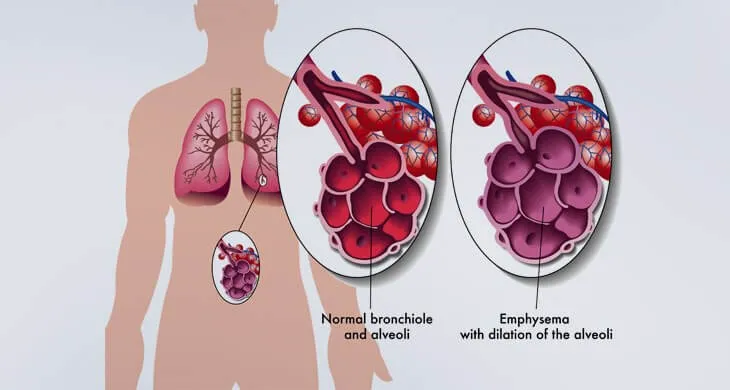
COPD Symptoms:
- Shortness of breath and noisy breathing.
- Severe cough and changes in the color of nails.
- Trouble in eating and sleeping.
- Early morning headache and difficulty in talking.
COPD Treatment:
As a first step to treat this condition, healthcare providers ask the patients to quit smoking. The victim also needs to avoid the triggers, like air pollution. The use of medicines helps to make the symptoms less severe.
Similarly, regular physical exercise can improve the overall health of the victim. In more severe cases, you will have to go for the surgical therapy.
Pneumonia
Pneumonia is an inflammatory lung disease which affects the microscopic sacs of lungs. The causes are many. However, the most common is infection. Infection of this type occurs due to bacteria and virus. Common symptoms are fever, cough and shortness of breathing. Antibiotics are effective against the lung infections in such lungs diseases.
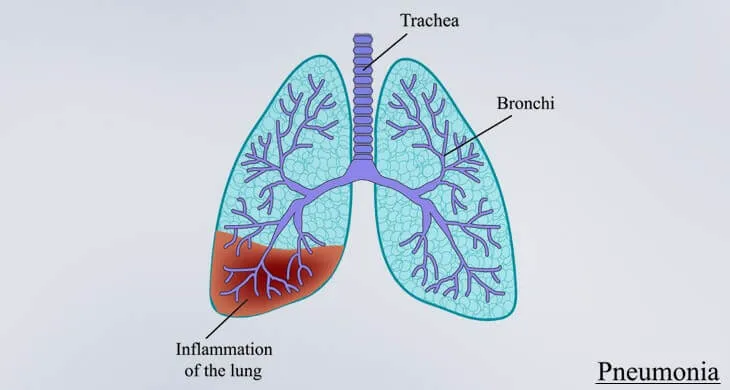
Pneumonia Symptoms:
- Fever and pain in the muscles.
- Fatigue and chest pain.
- Sore throat and the enlargement of lymph nodes in the neck.
- Coughing, rapid breathing and shortness of breath.
Pneumonia Treatment:
The treatment of pneumonia depends on the causative factor. For example, the most common cause of pneumonia is the bacterial infection. In this case, doctors prescribe certain antibiotics which have a high cure rate. Improvement in the symptoms occurs within 2 to 3 days.
Chronic Bronchitis
Chronic Bronchitis is obstructive lung disease. It is one of the most common diseases of lungs. Meanwhile, chronic bronchitis is one of the two main types of COPD. The symptoms include long-term cough, which may last for two years. Shortness of breathing is another symptom of Bronchitis. Tobacco Smoking, polluted areas and allergies are major causes for this type of lungs diseases.
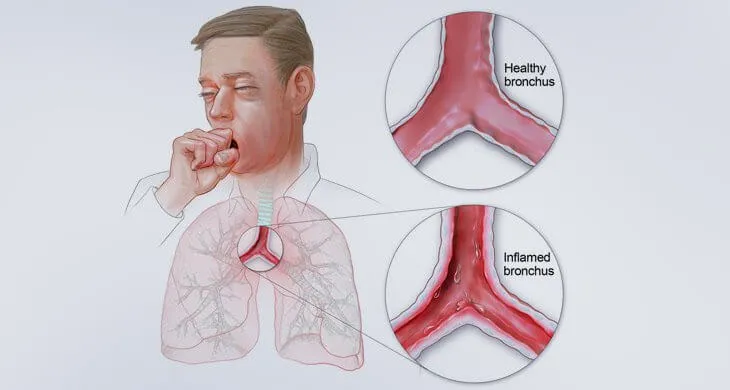
Chronic Bronchitis Symptoms:
- Discomfort in chest and shortness of breath.
- Fatigue and slight fever with fatigue.
- Production of differently colored sputum, including green, yellowish-gray and white.
- Persistent cough.
Chronic Bronchitis Treatment:
While suggesting suitable therapy for chronic bronchitis, one has to take into account the severity of the condition. The focus of the chronic bronchitis treatment therapy is to alleviate the symptoms. The healthcare providers usually prescribe a combination of medications. They help to open the bronchial airways. Doctors also advise the victims to avoid contact with the environmental irritants.
Lung Cancer
One of the fatal lungs diseases, the lung cancer occurs when unusual cells growth arises in tissues of lung. If not treated timely, it can spread in other parts of the body as well. The most common cause is Smoking and symptoms include weight loss and breathing problem. Patient’s survival depends on the stage of disease and many other aspects. Small Cell Lung Carcinoma and Non- Small Cell Lung Carcinoma are two types of lung cancer.
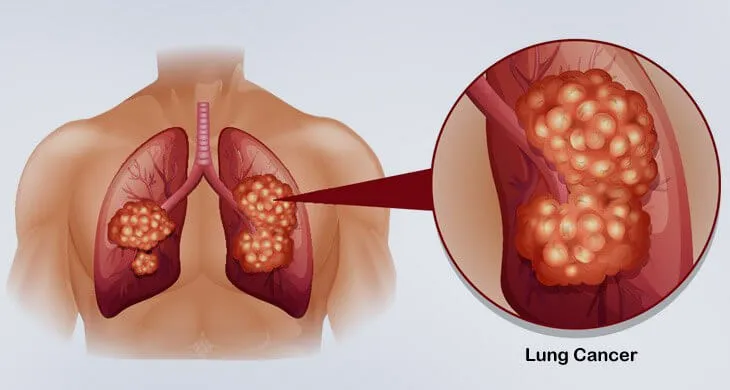
Lung Cancer Symptoms:
- Cough that becomes worse with the passage of time.
- Coughing up bloody sputum.
- Loss of appetite followed by weight loss.
- Chest discomfort which becomes worse with breathing, laughing and coughing.
Lung Cancer Treatment:
The suggestions and application of a suitable treatment method depends on the specific type of lung cancer. For an instance, if an individual is suffering from non-small cell lung cancer, they can utilize the options of radiotherapy, chemotherapy and surgery. Here again, different stages of the cancer will require a different therapy.
On the other hand, chemotherapy is the most common treatment option for small cell lung cancer. The patients can utilize the option of surgery only in case the cancer has spread to the mediastinal lymph glands. The mediastinal lymph glands are present in the center of the chest.
Pulmonary Fibrosis
Pulmonary fibrosis is one of the serious lungs diseases. When excessive fibrosis develops in lungs, the condition is referred to pulmonary fibrosis. Sometimes it is called scarring of lungs. Symptoms are shortness of breath, rapid weight loss, pain and weakness. Dust is the major cause of this disease.
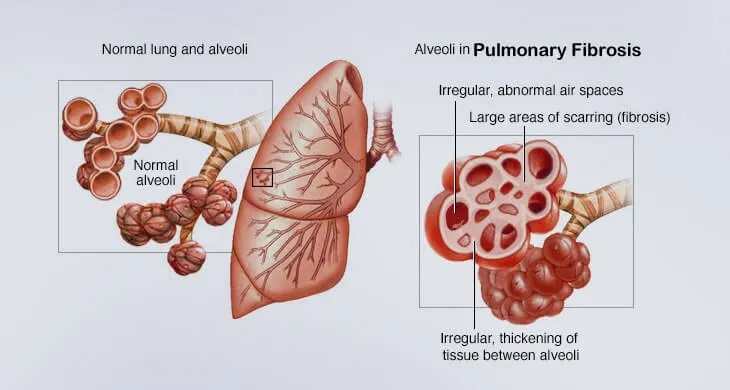
Pulmonary Fibrosis Symptoms:
- Dry cough and shortness of breath.
- Shallow breathing and tiredness.
- The tips of fingers and toes may become wide and rough through the process of clubbing.
- Gradual weight loss and pain in the joints.
Pulmonary Fibrosis Treatment:
It is usually difficult to reverse the scarring of lungs that has been caused by pulmonary fibrosis. However, the use of medications can prevent further progression of the disease. Other treatment options include oxygen therapy and pulmonary rehabilitation. However, the end stage of the disease needs lung transplant.
Sarcoidosis
Sarcoidosis is one of those lung diseases which have unknown causes. It is also known as Sarcoid. Sarcoid is a condition in which unusual collection of chronic inflammatory cells occurs in different organs in form of nodules.
It has many vague symptoms, for example, persistent tiredness, pain, weakness, and weight loss. Vision disorder, breathing problem, swelling and dry eyes are some other symptoms. Sarcoidosis can affect any organ of the body.
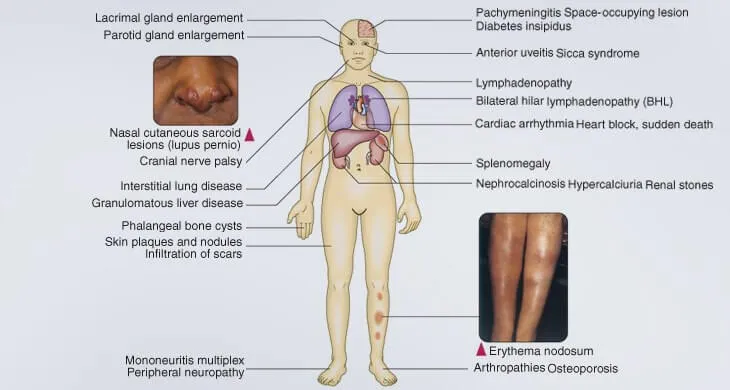
Sarcoidosis Symptoms:
- Appearance of reddish bumps and patches on the skin.
- Red eyes with blurred vision.
- Inflammation and pain in joints.
- Enlargement and tenderness of lymph nodes, especially, in the neck, groin and armpits.
Sarcoidosis Treatment:
There is no specific cure for the condition of sarcoidosis. But, interestingly, the symptoms start improving on their own without any treatment. Even then doctors prescribe certain medicines. The medicines make the symptoms less severe. Taking a well-balanced diet is useful. Also the use of a variety of fresh fruits and vegetables is very effective.
Cystic Fibrosis
Cystic Fibrosis in another painful condition on the list of lungs diseases. It occurs when sodium and chloride regulate abnormally across epithelium. Such a condition leads to thick secretions. Frequent use of antibiotics and medication for treating lungs infection can cause breathing problem.
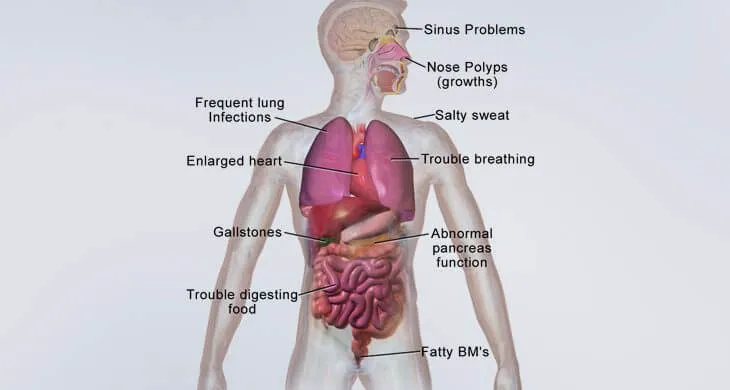
Cystic Fibrosis Symptoms:
- Sweating away too much salt that makes the skin taste salty.
- Wheezing and coughing up thick mucus.
- Development of polyps in the nose.
- Clubbing of fingers and toes.
Cystic Fibrosis Treatment:
Though there is no cure for cystic fibrosis, certain treatments can ease the symptoms. Thus, by the use of medicines, the victims are better able to breathe and get rid of the stomach problems. Other treatment options include airway clearance techniques and oxygen therapy.
Meanwhile, doctors may also recommend the use of enzyme pills and the vitamin supplements. The lung transplant is always an option. It is especially for the people who are suffering from severe lungs diseases. However, this can be very expensive and unaffordable.
Tuberculosis
Tuberculosis or TB arises when a tuberculosis patient sneezes or coughs in open air. Beside lungs, it can also affect several other organs of the body. The most familiar symptoms of tuberculosis are chronic cough, fever, weakness and weight loss.
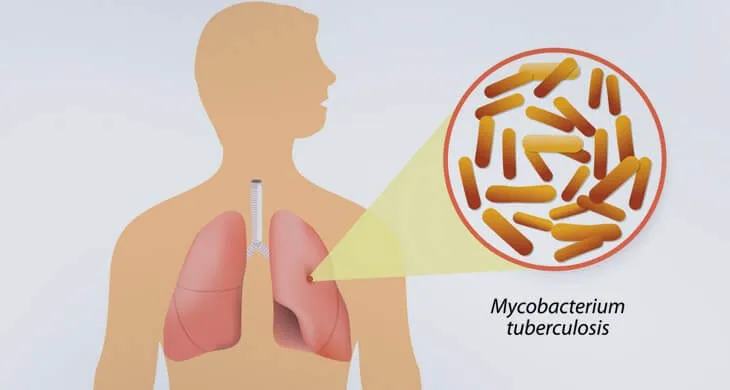
Tuberculosis Symptoms:
- Cough with thick, bloody mucous which may last for more than two weeks.
- Fever, fatigue and weakness.
- Chills, night sweats and loss of appetite.
- Discomfort in chest region, weight loss and shortness of breath.
Tuberculosis Treatment:
The United States Food and Drug Administration (FDA) has approved ten different drugs for the treatment of tuberculosis. The patients have to take several drugs for six to nine months. The choice of medications, however, depends on the type of TB. There are two types of tuberculosis, namely, latent TB and active TB.
For the latent type, the patients may take an antibiotic, isoniazid. It is effective in preventing the dormant infection from becoming active. On the other hand, the victims of active TB disease need to take a combination of several antibiotics for six months or more. These drugs will treat the infection and prevent the resistant bacteria from emerging in the body.


